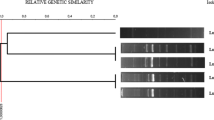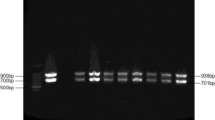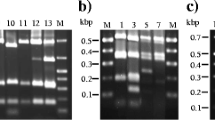Abstract
The major contamination sources, serogroups, biofilm-forming ability and biocide resistance of Listeria monocytogenes persistent in tilapia-processing facilities were assessed. Twenty-five processing-control points were examined twice in two factories, including whole tilapias, frozen fillets, water and food-contact surfaces. L. monocytogenes were detected in 4 and 20% of points of Factory A and B respectively, but at low concentrations. Contamination was due to inadequate handling of tilapias in the slaughter room of Factory A and to the application of ineffective sanitizing procedures in Factory B. Seven strains were characterized by RAPD-PCR using primers HLWL85, OPM-01 and DAF4. Genotypic similarity allowed tracing the contamination source of tilapia fillets in Factory B and detecting a prevalent strain in Brazilian tilapia-processing facilities. The serogroup II (including the serotype 1/2c) was the most frequently found, followed by serogroup I (1/2a) and III (1/2b), whereas the serotype 4b was not detected. All strains showed high biofilm-forming ability on stainless steel and polystyrene, but biofilm formation was positively correlated with the type of origin surface. Biofilms were highly resistant to peracetic acid and sodium hypochlorite, being required doses higher than those recommended by manufacturers to be eradicated. Peracetic acid was more effective than sodium hypochlorite, but the use of disinfectants with similar mechanisms of action increases the risk of cross-resistance. Case-by-case approaches are thus recommended to determine the sources and degree of contamination present in each factory, which would allow applying precise responses to control the persistence of bacterial pathogens such as L. monocytogenes.




Similar content being viewed by others
References
Abdollahzadeh E, Ojagh SM, Hosseini H, Irajian G, Ghaemi EA (2016) Prevalence and molecular characterization of Listeria spp. and Listeria monocytogenes isolated from fish, shrimp, and cooked ready-to-eat (RTE) aquatic products in Iran. LWT Food Sci Technol 73:205–211. doi:10.1016/j.lwt.2016.06.020
Abee T, Wouters JA (1999) Microbial stress response in minimal processing. Int J Food Microbiol 50(1–2):65–91. doi:10.1016/S0168-1605(99)00078-1
APHA (2013) Compendium of methods for the microbiological examination of foods. American Public Health Association (APHA), Washington DC
Baert L, Vandekinderen I, Devlieghere F, Coillie E, Debevere J, Uyttendaele M (2009) Efficacy of sodium hypochlorite and peroxyacetic acid to reduce murine norovirus 1, B40-8, Listeria monocytogenes, and Escherichia coli O157:H7 on shredded iceberg lettuce and in residual wash water. J Food Prot 72(5):1047–1054
Bartolomeu DAFS, Dallabona BR, Macedo REF, Kirschnik PG (2011) Contaminação microbiológica durante as etapas de processamento de filé de tilápia (Oreochromis niloticus). Arch Vet Sci 16(1):21–30. doi:10.5380/avs.v16i1.22788
Beltrame CA, Martelo EB, Mesquita RA, Barbosa J, Steffens C, Toniazzo G, Valduga E, Cansian RL (2015) Adhesion of Listeria monocytogenes to cutting board surfaces and removal by different sanitizers. J Verbrauch Lebensm 10(1):41–47. doi:10.1007/s00003-014-0923-7
Blackman IC, Frank JF, Frank F (1996) Growth of Listeria monocytogenes as a biofilm on various food-processing surfaces. J Food Prot 8(8):827–831. doi:10.4315/0362-028X-59.8.827
Boari CA, Pereira GI, Valeriano C, Silva BC, Morais VM, Figuieredo HCP, Piccoli RH (2008) Bacterial ecology of tilapia fresh fillets and some factors that can influence their microbial quality. Ciên Tecnol Aliment (Campinas) 28(4):863–867. doi:10.1590/S0101-20612008000400015
Brazil (2001) Regulamento técnico sobre os padrões microbiológicos para alimentos. Resolução No 12, de 2 de janeiro de 2001. Diário Oficial da República Federativa do Brasil, Brasília
Carbonera N, Cappelletti BM, Espírito-Santo MLP (2011) ISO 22000/HACCP associated with the presence of microorganisms in the processing of tilapia (Oreochromis niloticus) fillets. Qual Assur J 14:50–60. doi:10.1002/qaj.489
Carpentier B, Cerf O (2011) Review—Persistence of Listeria monocytogenes in food industry equipment and premises. Int J Food Microbiol 145(1):1–8. doi:10.1016/j.ijfoodmicro.2011.01.005
Cartwright EJ, Jackson KA, Johnson SD, Graves LM, Silk BJ, Mahon BE (2013) Listeriosis outbreaks and associated food vehicles, United States, 1998–2008. Emerg Infect Dis 19(1):1–9. doi:10.3201/eid1901.120393
Chae MS, Schraft H, Truelstrup Hansen L, Mackereth R (2006) Effects of physicochemical surface characteristics of Listeria monocytogenes strains on attachment to glass. Food Microbiol 23(3):250–259. doi:10.1016/j.fm.2005.04.004
Chapman JS (2003) Disinfectant resistance mechanisms, cross-resistance, and co-resistance. Int Biodeterior Biodegrad 51(4):271–276. doi:10.1016/S0964-8305(03)00044-1
Chen B-Y, Wang C-Y, Wang C-L, Fan Y-C, Weng I-T, Chou C-H (2016) Prevalence and persistence of Listeria monocytogenes in ready-to-eat tilapia sashimi processing plants. J Food Prot 79(11):1898–1903. doi:10.4315/0362-028X.JFP-16-149
Cruz CD, Silvestre FA, Kinoshita EM, Landgraf M, Franco BDGM, Destro MT (2008) Epidemiological survey of Listeria monocytogenes in a Gravlax salmon processing line. Braz J Microbiol 39:375–383
De-Beer D, Srinivasan R, Stewart PS (1994) Direct measurement of chlorine penetration into biofilms during disinfection. Appl Environ Microbiol 60(12):4339–4344
Doumith D, Buchrieser C, Glaser P, Jacquet C, Martin P (2004) Differentiation of the major Listeria monocytogenes serovars by multiplex PCR. J Clin Microbiol 42(8):3819–3822. doi:10.1128/JCM.42.8.3819-3822.2004
EFSA (2016) The European Union summary report on trends and sources of zoonoses, zoonotic agents and food-borne outbreaks in 2015. EFSA J 14(12):4634. doi:10.2903/j.efsa.2016.4634
FAO (2016) FAO yearbook. Fishery and aquaculture statistics 2014. Food and Agriculture Organization of the United Nations, Rome
Ferreira V, Wiedmann M, Teixeira P, Stasiewicz MJ (2014) Listeria monocytogenes persistence in food-associated environments: epidemiology, strain characteristics, and implications for public health. J Food Prot 77(1):150–170. doi:10.4315/0362-028X.JFP-13-150
Gaulin C, Lê M, Shum M, Fong D (2011) Disinfectants and sanitizers for use on food contact surfaces. National Collaborative Centre for Environment Health. http://www.ncceh.ca/sites/default/files/Food_Contact_Surface_Sanitizers_Aug_2011.pdf. Accessed 18 Feb 2017
Hansen CH, Vogel BF, Gram L (2006) Prevalence and survival of Listeria monocytogenes in Danish aquatic and fish-processing environments. J Food Prot 69(9):2113–2122. doi:10.4315/0362-028X-69.9.2113
Havelaar AH, Brul S, Jong A, Jonge R, Zwietering MH, Kuile BHT (2010) Future challenges to microbial food safety. Int J Food Microbiol 139:79–94. doi:10.1016/j.ijfoodmicro.2009.10.015
IBGE (2015) Produção da Pecuária Municipal. Ministério do Planejamento, Desenvolvimento e Gestão, Rio de Janeiro
Jamali H, Paydar M, Ismail S, Looi CY, Wong WF, Radmehr B, Abedini A (2015) Prevalence, antimicrobial susceptibility and virulotyping of Listeria species and Listeria monocytogenes isolated from open-air fish markets. BMC Microbiol 15:144. doi:10.1186/s12866-015-0476-7
Jami M, Ghanbari M, Zunabovic M, Domig KJ, Kneifel W (2014) Listeria monocytogenes in aquatic food products—a review. Compr Rev Food Sci Food Saf 13:798–813. doi:10.1111/1541-4337.12092
Junior PG, Assunção AWA, Baldin JC, Amaral LA (2014) Microbiological quality of whole and filleted shelf-tilapia. Aquaculture 433:196–200. doi:10.1016/j.aquaculture.2014.06.015
Kitis M (2004) Disinfection of wastewater with peracetic acid: a review. Environ Int 30(1):47–55. doi:10.1016/S0160-4120(03)00147-8
Kramarenko T, Roasto M, Meremäe K, Kuningas M, Põltsama P, Elias T (2013) Listeria monocytogenes prevalence and serotype diversity in various foods. Food Control 30:24–29. doi:10.1016/j.foodcont.2012.06.047
Langsrud S, Sidhu MS, Heir E, Holck AL (2003) Bacterial disinfectant resistance: a challenge for the food industry. Int Biodeterior Biodegrad 51:283–290. doi:10.1016/S0964-8305(03)00039-8
Lawrence LM, Harvey J, Gilmour A (1993) Development of a random amplification of polymorphic DNA typing method for Listeria monocytogenes. Appl Environ Microbiol 59:3117–3119
Mann CM, Markham JL (1998) A new method for determining the minimum inhibitory concentration of essential oils. J Appl Microbiol 84(4):538–544
Russell AD (2003) Similarities and differences in the responses of microorganisms to biocides. J Antimicrob Chemother 52(5):750–763. doi:10.1093/jac/dkg422
Saá-Ibusquiza P, Herrera JJR, Vázquez-Sánchez D, Cabo ML (2012) Adherence kinetics, resistance to benzalkonium chloride and microscopic analysis of mixed biofilms formed by Listeria monocytogenes and Pseudomonas putida. Food Control 25(1):202–210. doi:10.1016/j.foodcont.2011.10.002
Shimojima Y, Ida M, Nakama A, Nishino Y, Fukui R, Kuroda S, Hirai A, Kai A, Sadamasu K (2016) Prevalence and contamination levels of Listeria monocytogenes in ready-to-eat foods in Tokyo, Japan. J Vet Med Sci 78(7):1183–1187. doi:10.1292/jvms.15-0708
Sneath PHA, Sokal RR (1973) Numerical taxonomy: the principles and practice of numerical classification. Freeman, San Francisco
Stanga M (2010) Sanitation: cleaning and disinfection in the food industry. Wiley-VCH Verlag GmbH & Co. KGaA, Weinheim. doi:10.1002/9783527629459
Struelens MJ, Bauernfeind A, Van-Belkum A, Blanc D, Cookson BD, Dijkshoorn L, El-Solh N, Etienne J, Garaizar J, Gerner-Smidh P, Legakis N, de-Lencastre H, Nicolas MH, Pitt TL, Römling U, Witte W, Legakis N (1996) Consensus guidelines for appropriate use and evaluation of microbial epidemiologic typing systems. Clin Microbiol Infect 2:2–11. doi:10.1111/j.1469-0691.1996.tb00193.x
Välimaa A-L, Tilsala-Timisjärvi A, Virtanen E (2015) Rapid detection and identification methods for Listeria monocytogenes in the food chain—a review. Food Control 55:103–114. doi:10.1016/j.foodcont.2015.02.037
Vallim DC, Hofer CB, Lisbôa RDC, Barbosa AV, Rusak LA, Reis CMF, Hofer E (2015) Twenty years of Listeria in Brazil: occurrence of Listeria species and Listeria monocytogenes serovars in food samples in Brazil between 1990 and 2012. Biomed Res Int 2015:540204. doi:10.1155/2015/540204
Verran J, Packer A, Kelly P, Whitehead KA (2010) The retention of bacteria on hygienic surfaces presenting scratches of microbial dimensions. Lett Appl Microbiol 50(3):258–263
Vogel BF, Jørgensen LV, Ojeniyi B, Huss HH, Gram L (2001) Diversity of Listeria monocytogenes isolates from cold-smoked salmon produced in different smokehouses as assessed by Random Amplified Polymorphic DNA analyses. Int J Food Microbiol 65:83–92
Walter EHM, Nascimento MS, Kuaye AY (2009) Efficacy of sodium hypochlorite and peracetic acid in sanitizing green coconuts. Lett Appl Microbiol 49(3):366–371. doi:10.1111/j.1472-765X.2009.02670.x
Wernars K, Boerlin P, Audurier A, Russell EG, Curtis GDW, Herman L, Mee-Marquet N (1996) The WHO multicenter study on Listeria monocytogenes subtyping: random amplification of polymorphic DNA (RAPD). Int J Food Microbiol 32:325–341. doi:10.1016/S0168-1605(96)01146-4
Wiedmann-al-Ahmad M, Tichy HV, Schön G (1994) Characterization of Acinetobacter type strains and isolates obtained from wastewater treatment plants by PCR fingerprinting. Appl Environ Microbiol 60:4066–4071
Wu S, Wu Q, Zhang J, Chen M, Yan Z, Hu H (2015) Listeria monocytogenes prevalence and characteristics in retail raw foods in China. PLoS ONE 10(8):e0136682. doi:10.1371/journal.pone.0136682
Wulff G, Gram L, Ahrens P, Vogel BF (2006) One group of genetically similar Listeria monocytogenes strains frequently dominates and persists in several fish slaughter- and smokehouses. Appl Environ Microbiol 72(6):4313–4322. doi:10.1128/AEM.02288-05
Acknowledgements
This work was financially supported by the São Paulo Research Foundation (FAPESP 2014/20590-0).
Author information
Authors and Affiliations
Corresponding author
Rights and permissions
About this article
Cite this article
Vázquez-Sánchez, D., Galvão, J.A. & Oetterer, M. Contamination sources, serogroups, biofilm-forming ability and biocide resistance of Listeria monocytogenes persistent in tilapia-processing facilities. J Food Sci Technol 54, 3867–3879 (2017). https://doi.org/10.1007/s13197-017-2843-x
Accepted:
Published:
Issue Date:
DOI: https://doi.org/10.1007/s13197-017-2843-x




